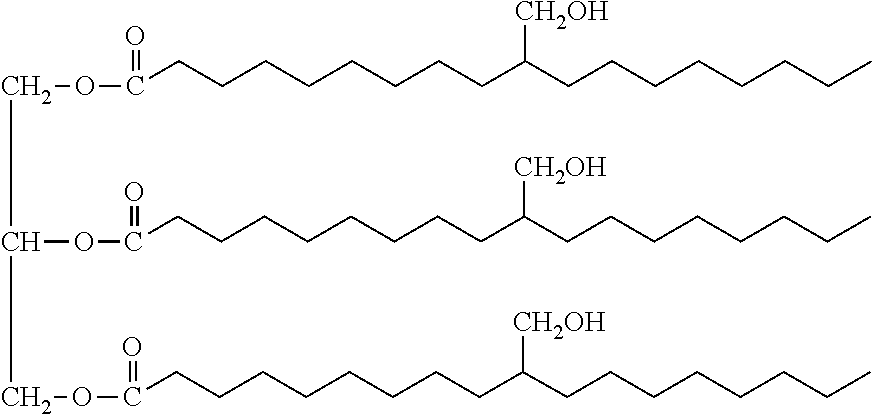Biobased-petrochemical hybrid polyols
a biobased, petrochemical technology, applied in the field of polyol making, can solve the problems of slow reaction rate, insufficient hydrophobicity, and inability to make from renewable resources,
- Summary
- Abstract
- Description
- Claims
- Application Information
AI Technical Summary
Benefits of technology
Problems solved by technology
Method used
Image
Examples
example 1
PO Homopolymers by Cationic Mechanism
[0055]A glass reactor with mantle linked to a cryostat, reflux condenser, stirrer, dropping funnel, thermometer and nitrogen admission was charged with 50 parts by weight of a soybean polyol obtained by the reaction of epoxidized soybean oil with methanol (having hydroxyl number OH#=171 mg KOH / g, viscosity of 7.3 Pa·s at 25° C., number average molecular weight Mn=1100 and functionality f=3.2 OH groups / mol), 50 parts by weight of methylene chloride (CH2Cl2) as a solvent and 0.22% by weight HBF4 solution (in a solution of diethyl ether that is 54% by weight HBF4) as a cationic catalyst. Nitrogen gas was bubbled through the reaction mixture for 20-30 minutes in order to generate an inert atmosphere. The reaction mass was cooled to 0° C. The monomer, propylene oxide (PO) was added to the reaction mixture, at a very slow addition rate over 4-8 hours using a dropping funnel while maintaining the temperature of the reaction mass in the range of 0-10° C....
example 2
Random Copolymers of Propylene-Oxide (PO) and Ethylene Oxide (EO) by Cationic Mechanism
[0056]Random copolymers of PO-EO were obtained in the same way as the PO homopolymers of Example 1 except that, instead of PO, a homogeneous mixture of PO-EO (containing around 15% by weight EO) was added to the soy-polyol starter. Thus, the same reactor, as described in Example 1, was charged with 50 parts by weight soy polyol having an OH#=171 mg KOH / g, 50 parts by weight of methylene chloride and 0.22% by weight HBF4 solution (in a solution of diethyl ether that is 54% by weight HBF4). 130 parts by weight of a homogeneous mixture of PO-EO containing 15% by weight EO, at 0-9° C., was added slowly over 4-6 hours. In order to prevent loss of EO by evaporation (b.p.=10.8° C.), a funnel with mantle, linked to a cryostat, having a cooling fluid at a temperature in the range of −5 to 0° C. was used. After the catalyst neutralization, filtration and solvent removal by vacuum distillation, as in Example...
example 3
Random Copolymers of Propylene Oxide (PO) and 1,4 butylene oxide (THF) by Cationic Mechanism
[0057]The reactor described in Example 1 was charged with 50 parts by weight of soybean polyol having an OH#=171 mg KOH / g, 65 parts by weight of tetrahydrofuran (THF), and 0.22% by weight HBF4 solution (in a solution of diethyl ether that is 54% by weight HBF4). The temperature of the reaction mass was maintained at 15 to 25° C. After that, 65 parts by weight of PO were added slowly over 4 to 6 hours using a dropping funnel while maintaining the temperature between 15 to 25° C. After the addition of the total quantity of monomer, the reaction mixture was stirred for around 1 hour for the complete consumption of unreacted PO and THF monomers to occur. The removal of the acidic catalyst was the same as in Example 1. The unreacted monomers were removed by vacuum distillation. Around 5 parts of a liquid, which was shown to be tetrahydrofuran, was collected. The result was a transparent hybrid pol...
PUM
| Property | Measurement | Unit |
|---|---|---|
| temperature | aaaaa | aaaaa |
| temperature | aaaaa | aaaaa |
| temperature | aaaaa | aaaaa |
Abstract
Description
Claims
Application Information
 Login to View More
Login to View More - R&D
- Intellectual Property
- Life Sciences
- Materials
- Tech Scout
- Unparalleled Data Quality
- Higher Quality Content
- 60% Fewer Hallucinations
Browse by: Latest US Patents, China's latest patents, Technical Efficacy Thesaurus, Application Domain, Technology Topic, Popular Technical Reports.
© 2025 PatSnap. All rights reserved.Legal|Privacy policy|Modern Slavery Act Transparency Statement|Sitemap|About US| Contact US: help@patsnap.com



